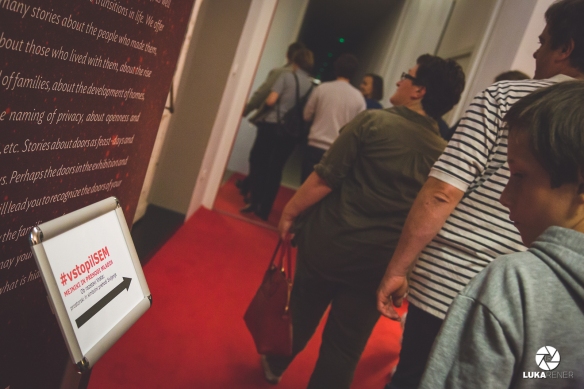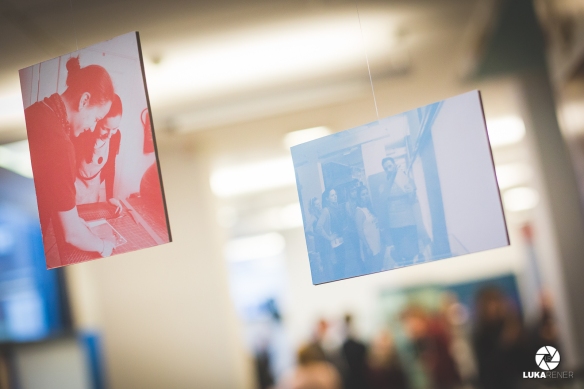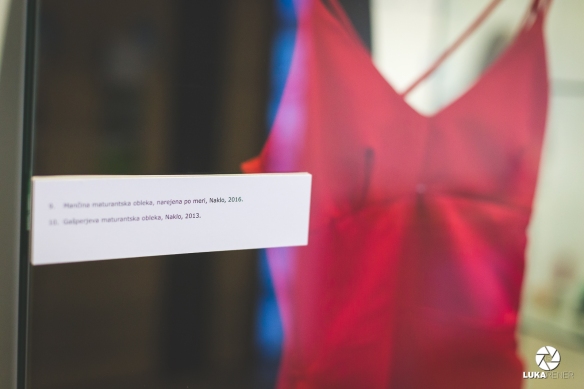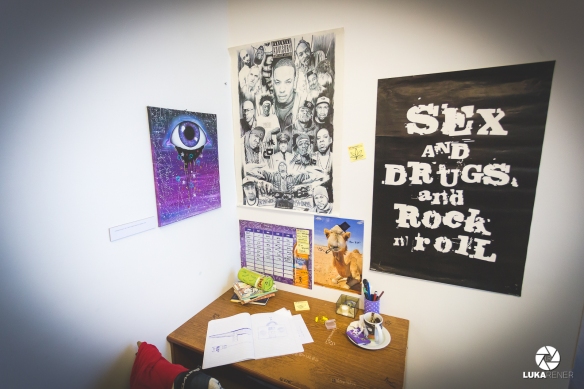A review of an exhibition created by students of ethnology and cultural anthropology in cooperation with Slovene Ethnographic Museum
*the title of the exhibition is a pun: SEM = Slovene Ethnographic Museum AND I have
Tina Palaić
A few weeks ago I attended Družabnice, an event, organized as the accompanying programme of the personal exhibition entitled #I have entered: turning points and passages of the youth (#vstopilSEM: mejniki in prehodi mladih). It was prepared in the Slovene Ethnographic Museum by the young authors of the exhibition. Participants talked about different experiences we had during the passage from our youth to adulthood. I was so inspired by the event that after one week I participated in another one – with different guests and on different topic. The idea of Družabnice, which establishes museum as a safe and confidential space for exchange of participants’ personal experiences as well as conversation about their dilemmas, decisions and reflections, encouraged me to do the research about the background of exhibition making. This is particularly interesting, because exhibition #I have entered is made by the young, who do not get such an opportunity in museums on a regular basis.
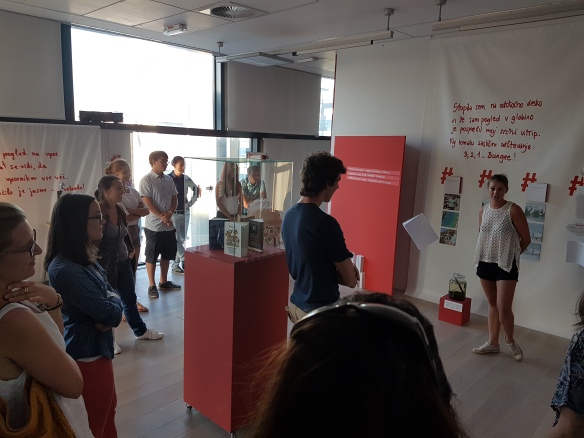
Družabnice, accompanying programme of the exhibition #I have entered. At the beginning we were strolling through the exhibition and authors shared selected stories with us. Image: Pija Japelj
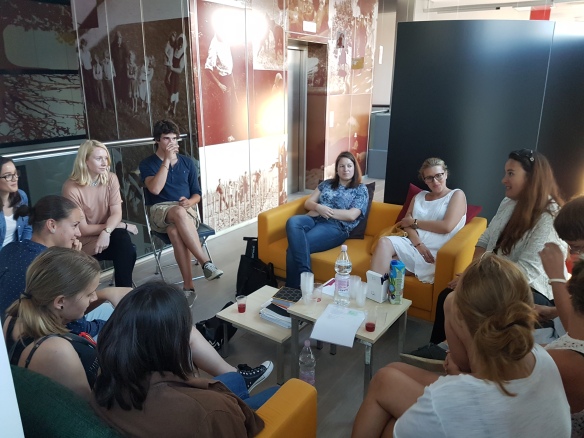
Družabnice establishes a museum as safe and confidential space for conversations about different themes. Image: Pija Japelj
An exhibition about their turning points and passages was created by students in the Department of Ethnology and Cultural Anthropology, Faculty of Arts, University of Ljubljana; faculty department proposed the cooperation to the Slovene Ethnographic Museum. Within the second permanent exhibition, entitled I, We and Others: Images of My World, the Museum enables individuals or groups to introduce their personal heritage through the creation of their own exhibitions. Such cooperation with visitors allows the museum institution to present different perspectives as well as include unrecognized heritage stories. However it is always different and demands exhaustive professional considerations. It was the same in collaboration with students of the 2nd grade of the first cycle degree, who attended the practical class Ethnology of Slovenes under the supervision of professor Miha Kozorog, PhD, and museum curator Polona Sketelj, MSc. Professor Miha Kozorog introduced the concept of rites of passage and students made connections with their passages from youth to adulthood. Museum curator Polona Sketelj presented them the exhibition Doors. Spatial and Symbolic Passageways of life, which is the basis for students’ exhibition in terms of content and design. Furthermore she explained processes of musealization and guided them through the exhibition making. Eventually the exhibition was created by a group of 12 students, who thus also did their obligatory student practice.
Museums can include individuals or groups as merely consultants, as interlocutors in museum research, or they invite them to participate in all phases of museum work. I spoke with great interest with museum curator Polona Sketelj and some authors of the exhibition about their cooperation and the level of students’ inclusion in the museum work. Polona Sketelj emphasized the double role of the students in that case – as ethnologists they practiced self-observation and self-reflection. Therefore, they collected their personal adolescent experiences and in the process of musealization transformed them into exhibition narrative. It was of extreme importance, said Polona Sketelj, that students were respectful and gained understanding, that there are no right or wrong passages, but only different stories, only nuances of the same passages. Since the young investigated their own experiences, the display does not allow generalizations about young people. For this reason she directed students to reflect and exhibit their own personal development. However, she did not want to interfere in the concept of the exhibition too much; it was of great importance for her that students made it by themselves. She directed them to in-depth consideration about the exhibition content with several questions: what is the purpose of the exhibition, what message do they want to communicate to the audience, and how will they do it. She emphasized their responsibility – as exhibition authors students are responsible for the correct use of anthropological theory, adequate language, sensible visual elements. Some exhibition content demanded more ethical consideration. In these cases, museum curator guided students with directional conversation as well.
One of their dilemmas was the level of authors’ personal data protection. Students exhibited some of the documents, where such information are clearly visible. Each author decided to display them on the basis of her/his own consideration. According to Polona Sketelj, an argument for doing so is also the nature of such personal exhibitions, which display personal stories.
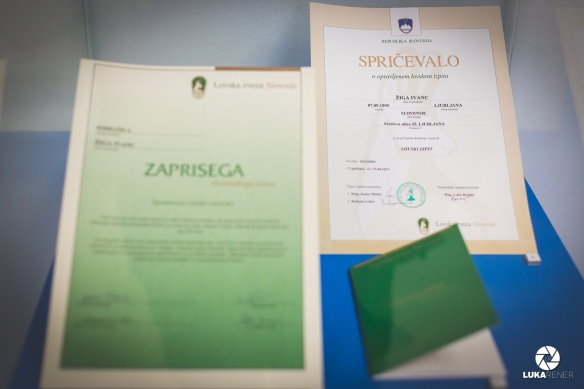
This certificate proves that its owner has passed the hunting exam. It was very important passage for him, which has brought the feeling of belonging to one of the hunting associations in Slovenia. Image: Luka Rener
The intimacy of authors’ stories is indicated also in the display of several poems depicting emotional distress and searching for the meaning of life, written by one of the students. Some of them also described different ways young people use to get out of everyday or occasional anxieties. One of them is committing suicide, which they wanted to present with a puppet, hanging in the museum lobby. However at the end they did not decide for the puppet, because no one has had that kind of experience by themselves. They followed the principle to show only the content connected personally with them.
Authors included one student’s personal drug collection as well, to show experimenting with drugs as one of the important passages from the youth to adulthood. This is another level of intimacy visitors might experience strolling through the exhibition. Students asked themselves how to display drugs and what effect may this small collection have on the audience. They decided to represent drugs as one of the challenges they are confronted with, and they included also authorial images to show the consequences of taking drugs.
Exhibition #I have entered is based on students’ personal stories. They present their turning points and passages within two chapters, which show us their attitude towards adulthood. The chapter #with you (#z vami) includes official passages, which are often proven by the government and clearly seen in the society, for instance: adulthood, driving licence, matura examination, enrollment in faculty, first job. The chapter #alone (#sami) includes those passages, that are hidden and often on the edge, and young people can get punished for their activity – however they are essential for them in the process of becoming adults. Within this chapter authors speak about the perceptions and changing of their bodies, first sexual experience, drug experimentation, entertainment, adrenaline sports, and – interestingly – they included the passage into motherhood in this chapter as well. In addition, there is a small part of the exhibition between these two, which shows us the processes of the exhibition making through the selected images. From my perspective this part of the display is very important, since the authors had to reflect the process of exhibition making in order to present it, as well as the audience can get information about it and thus might develop more complex understanding of the exhibition.
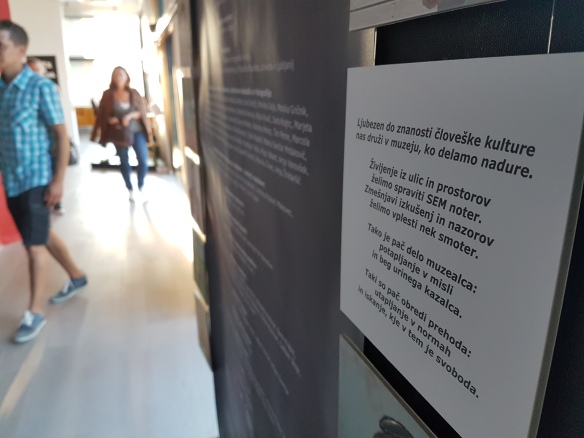
A poem, which reflects the job of a museum curator, was written by one of the exhibition authors on the basis of his own experience in the museum. Image: Pija Japelj
Through an exhibition design, which is quite expressive, authors emphasized very important dimension of their everyday life: social networks. They communicate most of the news through Facebook, Instagram, Twitter. That was the basis for the use of #hashtag sign (for instance with the title of an exhibition as well as titles of both exhibition chapters), and for narration of their personal stories in the form of Facebook posts. However, more intimate and personal texts written by the hand are still important for them therefore, they included texts on the walls, poems, and several drawings with different motifs as the second level of information.
A visitor is confronted with a series of passages, and this is why the exhibition can appear as chaotic as well as superficial. However this atmosphere created by – perhaps at first sight accidental – embedment of objects and stories in the space, shows us another feature of authors’ world. It depicts the seeking of their own, individual pathways in the series of passages into adulthood, some of which are obligatory and other they simply wished to pass, in the often very complex reality. On one hand, this reality is not easy to understand, and on the other, it is even less easy to live it to the full.

The youth reflect on their bodies a lot – how they change and mature. Their experiences and thoughts are presented in the form of Facebook posts. Image: Luka Rener
Through the exhibition the youth speak very openly about themselves. They perceive museum as their own space, as confidential environment, where they can safely share their personal stories. This feeling was even more present on Družabnice, an event, proposed and organized by them. One of the students shared her opinion about cooperation with the museum:
»Cooperation with the museum has special value, because it allows students to get to know the museum work in practice. Personally it means a lot to me, since through the work here I have realized, what I am interested in in my life and in which direction I want to build my career. I am also very lucky, that this kind of work is connected to my leisure time as well, because I have been encountering with the cultural heritage all the time.
After the opening of the exhibition #I have entered there were a lot of questions. What to do with the exhibition? Will people come to the museum to see it? Will our message reach them? At the end we have found a great solution – Družabnice. We combined guided tour through the exhibition and conversation with invited guests. Visitors’ response was absolutely positive and I hope, that we will continue with Družabnice in the museum, because we all need a safe place to share our moments, thoughts, and stories.«
Pija Japelj
You can see the exhibition #I have entered in the Slovene Ethnographic Museum until November 2016. Due to the outstanding feedback young authors want to develop Družabnice also in connection with other exhibitions. You just need to check all the inspiring events they have prepared for us!
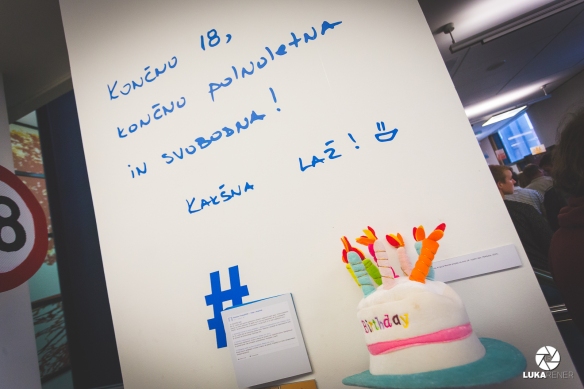
Adulthood is one of the official passages. The text on the wall says: “Finally 18, I am finally an adult and free! What a lie!” Image: Luka Rener

